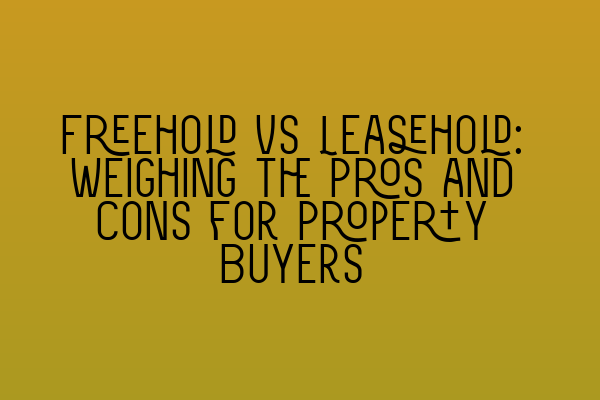Freehold vs Leasehold: Weighing the Pros and Cons for Property Buyers
When it comes to purchasing a property, there are various factors to consider, one of which is the type of ownership. In the UK, the two main types of property ownership are freehold and leasehold. Understanding the differences between these two forms of ownership is crucial in making an informed decision as a property buyer. In this blog post, we will delve into the pros and cons of freehold and leasehold properties, helping you weigh your options before making a decision.
Freehold Ownership:
Let’s start by exploring freehold ownership. When you buy a freehold property, you are essentially buying the property and the land it stands on outright. This means that you will have complete ownership and control over the property for an indefinite period. Freehold ownership is commonly associated with houses, although it is also possible to find freehold flats or apartments.
Pros of Freehold Ownership:
1. Complete Control: As a freehold owner, you have the freedom to make any alterations or modifications to your property without seeking permission from anyone else. This provides you with the flexibility to create your dream home according to your preferences and needs.
2. No Ground Rent: Unlike leasehold properties, freehold properties do not require payment of any ground rent to a landlord. This can save you money in the long run and provide you with additional financial freedom.
3. Potential for Property Value Growth: Freehold properties generally have a higher potential for long-term value growth compared to leasehold properties. This is because you have full control over the property and land, allowing you to take advantage of any improvements or developments in the area.
Cons of Freehold Ownership:
1. Maintenance Responsibility: As a freehold owner, you are solely responsible for the maintenance and repairs of your property. This can be a significant financial burden, especially if unexpected maintenance issues arise.
2. Limited Amenities: Freehold properties may not offer the same level of amenities and communal spaces as leasehold properties, as they do not typically come with shared facilities such as gyms or gardens.
Leasehold Ownership:
Now, let’s shift our focus to leasehold ownership. In a leasehold property, you own the property for a fixed period of time, as specified in the lease agreement. The land on which the property is situated is owned by a landlord, also known as the freeholder. Leasehold ownership is most commonly associated with flats, apartments, and some houses.
Pros of Leasehold Ownership:
1. Maintenance and Repairs: In most leasehold properties, the responsibility for maintenance and repairs lies with the landlord or management company. This alleviates some of the financial burden and ensures that communal areas are well-maintained.
2. Shared Amenities: Leasehold properties often come with shared amenities such as gardens, parking spaces, and communal areas. This can add value to your living experience and provide additional facilities that may not be available in freehold properties.
3. Lower Initial Purchase Price: Leasehold properties tend to have a lower initial purchase price compared to freehold properties. This can make them more affordable and accessible to first-time buyers or individuals working with a limited budget.
Cons of Leasehold Ownership:
1. Ground Rent and Service Charges: Most leasehold properties require the payment of ground rent and service charges to the freeholder. These charges can vary significantly and may increase over time, potentially impacting your financial stability in the long run.
2. Limited Control: As a leasehold owner, you have limited control over the property. You may need to seek permission from the freeholder before making any alterations or changes to the property, which can restrict your ability to personalize your home.
3. Lease Expiry: Leasehold properties have an expiry date, typically ranging from 99 to 999 years. Once the lease expires, ownership of the property reverts back to the freeholder. While lease extensions can be negotiated, they often come with additional costs and complexities.
Conclusion:
Choosing between freehold and leasehold ownership is a significant decision that depends on your individual circumstances and preferences. Freehold ownership offers complete control and potential for property value growth, but comes with the responsibility of maintenance. Leasehold ownership provides shared amenities and reduced initial costs, but comes with ongoing ground rent and limited control. It is essential to weigh the pros and cons carefully and seek professional advice if necessary.
At SQE Property Law & Land Law, we provide expert guidance and support on all aspects of property ownership to ensure that you make an informed decision. Contact us today to learn more about our services and how we can assist you with your property buying journey.
Related Articles:
– SQE 1 Practice Exam Questions
– SQE 1 Practice Mocks FLK1 FLK2
– SQE 2 Preparation Courses
– SQE 1 Preparation Courses
– SRA SQE Exam Dates
